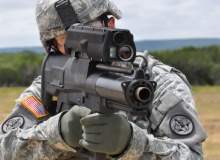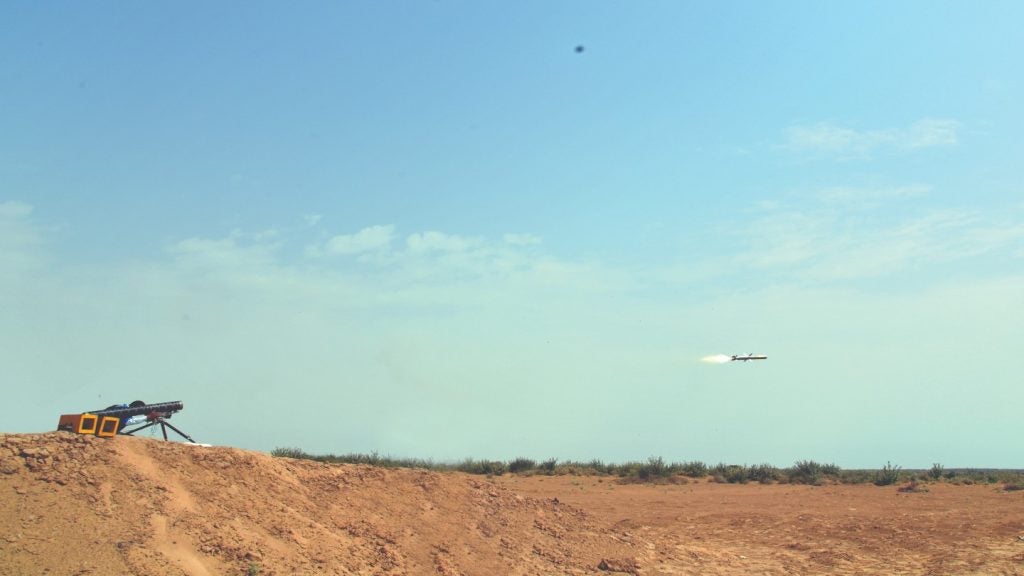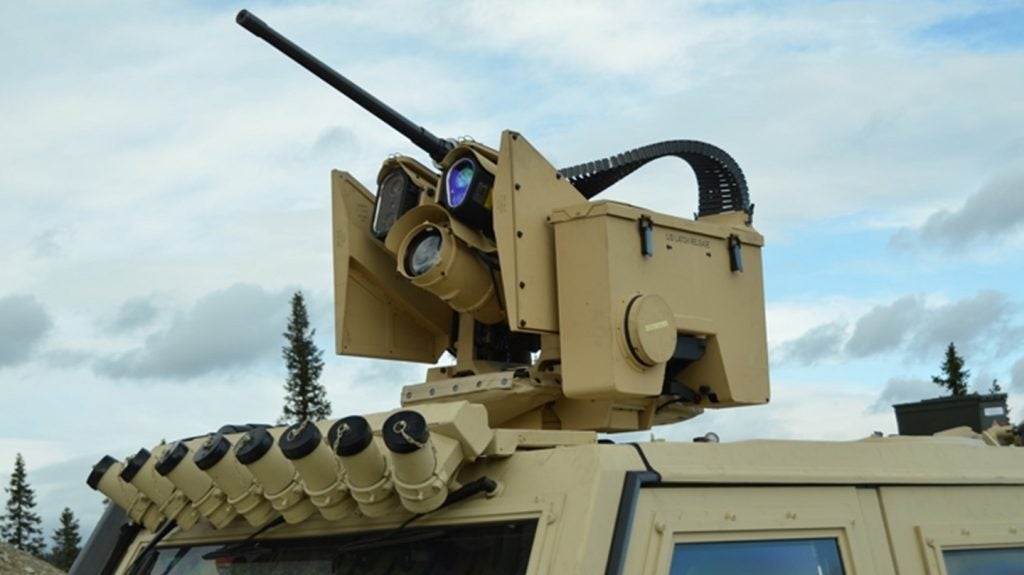

Targeting technology used to be the domain of guided missiles, but as sensors and control systems have become smaller and cheaper, similar concepts have been applied to infantry soldier weapons. Like something out of the futuristic Call of Duty game scenarios, near-future soldiers will be able to shoot around corners, target hidden enemies and have bullets change path mid-flight. While not entirely ‘fire and forget’, they greatly enhance accuracy.
XM-25 – The Punisher stalks the battlefield
When US Army soldiers nickname a weapon ‘The Punisher’, the manufacturers can be assured they’re on to a winner. In this case, the XM-25 Punisher is known more formally as the Counter Defilade Target Engagement System or Individual Semiautomatic Air Burst System.
The $35,000 XM-25 system by Alliant Techsystems and Heckler & Koch features an array of sights, sensors and lasers housed in a Target Acquisition Fire Control (TAFC) unit on top of a rifle-style body, with an oversized magazine behind the trigger mechanism and an unusually short barrel. Soldiers can use the TAFC with High Explosive Air Burst (HEAB) rounds to engage enemy forces located in the open and behind cover, including walls, rocks, trenches or inside buildings. HEAB is specifically designed to precisely shoot an explosive round that can pinpoint and incapacitate targets at distances of up to 700 metres.
Using a similar technology to laser-guided missile launchers, a laser targeting system gauges the distance to the target, from which the soldier can add or subtract up to three metres to control where the round will explode in relation to the target. Once in flight, a computer chip inside the ammunition receives information from the scope about how far it should travel before exploding, peppering the target with fragments. The semi-automatic magazine of the weapon houses four 25mm rounds and built-in thermal sight ensuring that the XM-25 can be employed in all weather and lighting conditions.
See Also:
Could Turkey’s drive for self-sufficiency affect a decades-old relationship with NATO and foreign suppliers?.
How well do you really know your competitors?
Access the most comprehensive Company Profiles on the market, powered by GlobalData. Save hours of research. Gain competitive edge.

Thank you!
Your download email will arrive shortly
Not ready to buy yet? Download a free sample
We are confident about the unique quality of our Company Profiles. However, we want you to make the most beneficial decision for your business, so we offer a free sample that you can download by submitting the below form
By GlobalDataPrototypes of the weapon were deployed in nine operational missions in Afghanistan as part of the weapon’s forward operational assessment.
While much investment in futuristic weaponry was dropped during recent defence cuts, XM-25 was singled out to be carried forward, ensuring that, even as budgets feel the squeeze, the combatant on the front line would carry the latest in lethality and protection -part of the US military’s favoured ‘shock and awe’ tactic.
However, it faced having its funding cut in July 2013 after a gun exploded in a live-fire exercise, and soldiers criticised its cumbersome weight and size limited ammunition capacity. Despite this, the Punisher may move to low-rate initial production by August 2014 and could be combat-ready by the end of 2015.
Guided bullets are bang on target
XM-25 relies on its launch system to accurately hit its target but the US Defense Advanced Research Projects agency (DARPA) is working on the ultimate in targeting technology – homing bullets. While few details have been made available, the Extreme Accuracy Tasked Ordnance (EXACTO) system appears to use dead-reckoning to home in on its target.
DARPA designed EXACTO to improve the aim of snipers using rifles at standoff range, especially in dusty and high wind conditions, where a shot that misses can give away the position of the shooter. Optical sighting technology and a real-time guidance system that includes gyroscopes, accelerometers and an atomic clock combine to direct the manoeuvrable bullet to its target, compensating for any factors that might have driven it off course in-flight.
DARPA has carried out the design, integration and demonstration of aero-actuation controls, power sources, optical guidance systems, and sensors under Phase II of the programme and the agency is currently working towards a system-level live-fire test and technology refinement to enhance and improve performance.
And DARPA is not alone in working on smart bullets. Researchers at Sandia National Laboratories’ Intelligent Systems, Robotics, & Cybernetics Precision Micro Assembly Lab have developed a self-guided .50mm projectile to be fired from a smooth-bored gun barrel. A guided munition needs to eliminate the spinning effect brought about by rifling so it can turn towards its target rather than remain on a straight path.
As the bullet hurtles towards the laser-designated target guided by an on-board optical sensor, tiny electronic-actuator controlled fins steer the projectile, while a counterbalancing mass near the nose keeps it steady. Sandia claims its system greatly improves accuracy for long-distance shooting up to a mile away and, because of the way the targeting system constantly adjusts its flightpath, accuracy actually improves with distance.
Having completed analysis and testing design work, Sandia is working on a prototype for a field demonstration and is seeking a corporate partner.

Supporting systems
Worth around AUD 10 billion, LAND 400 will be the Australian Army’s most complex project to date. .
Smart weapons stand to change the very paradigm of infantry and sniper weapons and, as such, current military modelling software is not up to the job. The US Army Research Laboratory (ARL) is seeking to address this through its Smart Weapon End-to-End Performance Model (SWEEPM). SWEEPM is designed to replicate the effectiveness of all types of munitions from target acquisition to damage calculation. For weapons under development, researchers can virtually try out the effect of different shooting styles, and how external factors such as weather and moving targets influence accuracy.
"The Smart Weapon End-to-End Performance Model is a set of files and software that cover all impacts associated with firing a round and anything that affects the delivery of that round," says Dr William F Oberle, head of the Advanced Weapons Concepts Branch within ARL’s Weapons and Materials Research Directorate.
One of the first tasks for SWEEPM was to analyse a conceptual guided artillery round developed by ARL engineers.
"Since a large segment of the divisions work in the future would involve smart weapons and no existing model could be found, we chose to start development of what is now termed SWEEPM," Oberle adds.
Smart weapons look set to radically improve the firing accuracy of infantry soldiers. But given the projected cost increase over standard rounds, it is likely these specialised rounds and weapons will remain for exceptional tasks, mainly by snipers. However, if they catch on and achieve the same level of mass-manufacture as the missiles that inspired them, they could become equally ubiquitous. This begs the question; what will future ground battles be like if no shooter can miss their target?
Follow Berenice Baker on Google+


.gif)




